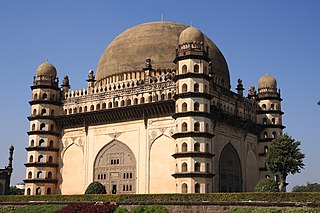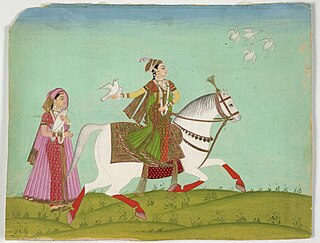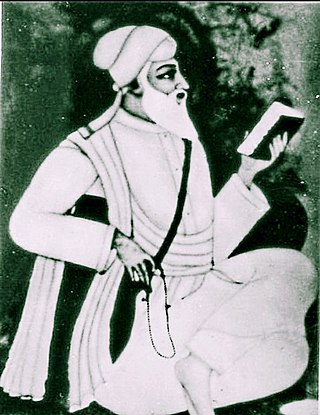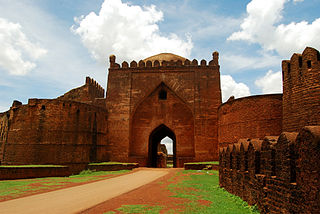| |||||
| Centuries: | |||||
|---|---|---|---|---|---|
| Decades: | |||||
| See also: | List of years in India Timeline of Indian history | ||||
This is a list of events in India in year 1627.
| |||||
| Centuries: | |||||
|---|---|---|---|---|---|
| Decades: | |||||
| See also: | List of years in India Timeline of Indian history | ||||
This is a list of events in India in year 1627.


The Deccan Sultanates were five late-medieval Indian kingdoms—on the Deccan Plateau between the Krishna River and the Vindhya Range—that were ruled by Muslim dynasties: namely Ahmadnagar, Berar, Bidar, Bijapur, and Golconda. The sultanates had become independent during the break-up of the Bahmani Sultanate. The five sultanates owed their existence to the declaration of independence of Ahmadnagar in 1490, followed by Bijapur and Berar in the same year. Golconda became independent in 1518, and Bidar in 1528.

Gol Gumbaz, also written Gol Gumbad, is a 17th-century mausoleum located in Bijapur, a city in Karnataka, India. It houses the remains of Mohammad Adil Shah, seventh sultan of the Adil Shahi dynasty, and some of his relatives. Begun in the mid-17th century, the structure never reached completion. The mausoleum is notable for its scale and exceptionally large dome. The structure is an important example of Adil Shahi architecture.

The Adil Shahi or Adilshahi, was a Shia, and later Sunni Muslim, dynasty founded by Yusuf Adil Shah, that ruled the Sultanate of Bijapur, centred on present-day Bijapur district, Karnataka in India, in the Western area of the Deccan region of Southern India from 1489 to 1686. Bijapur had been a province of the Bahmani Sultanate (1347–1518), and member of the Deccan Sultanates, before its political decline in the last quarter of the 15th century and eventual break-up in 1518. The Bijapur Sultanate was fully absorbed into the Mughal Empire on 12 September 1686, after its conquest by the Emperor Aurangzeb.

Ibrahim Adil Shah II was Sultan of the Sultanate of Bijapur and a member of the Adil Shahi dynasty. Under his reign the dynasty had its greatest period as he extended its frontier as far south as Mysore. He was a skilful administrator, artist, poet and a generous patron of the arts. He reverted to the Sunni orthodoxy of Islam, but remained tolerant of other religions, including Christianity. However, during his reign high-ranking Shiite immigrants became unwelcome and in 1590, he ordered the confinement of criers who read the khutba in the Shia form. After his reign, increasing weakness permitted Mughal encroachment and the successful revolt of the Maratha king Shivaji, who killed the Bijapur general Afzal Khan and scattered his army. The dynasty left a tradition of cosmopolitan culture and artistic patronage whose architectural remains are to be seen in the capital city of Bijapur.

Yusuf Adil Shah (1450–1510), referred as Adil Khan or Hidalcão by the Portuguese, was the founder of the Adil Shahi dynasty that ruled the Sultanate of Bijapur for nearly two centuries. As the founder of the newly formed Bijapur dynasty, Yusuf Adil Shah is credited with developing the town of Bijapur and elevating it to significant status.

Bijapur district, officially known as Vijayapura district, is a district in the state of Karnataka in India. The city of Bijapur is the headquarters of the district, and is located 530 km northwest of Bangalore. Bijapur is well known for the great monuments of historical importance built during the Adil Shahi dynasty.
Mallu Adil Shah, of the Adil Shahi dynasty, was the Sultan of the Bijapur Sultanate of modern-day southern India. He ruled for a short period in 1534, before being deposed and blinded.

Sultana Chand Bibi was an Indian ruler and warrior. She acted as the Regent of Bijapur Sultanate during the minority of Ibrahim Adil Shah II in 1580-1590, and regent of Ahmednagar Sultanate during the minority of her great nephew Bahadur Shah in 1595-1600. Chand Bibi is best known for defending Ahmednagar against the Mughal forces of Emperor Akbar in 1595.

The Jama Masjid of Bijapur is a congregational mosque in the Indian state of Karnataka. Initiated by Ali Adil Shah I of the Bijapur Sultanate in the 16th century, the mosque was never completed. It is the largest mosque in Bijapur, and has a capacity of 4000 worshippers.

Mohammed Adil Shah was the seventh sultan of Bijapur, ascending the throne in 1627. During his reign, he assisted the Mughals with their campaigns against the Ahmednagar Sultanate and signed a peace treaty with them in 1636. He died in 1656 and was buried in the Gol Gumbaz.

Ali Adil Shah II was the 8th Sultan of Bijapur. He succeeded to the throne of Bijapur through the efforts of the Prime Minister Khan Muhammad and the Queen, Badi Sahiba, sister of Qutb Shah of Golkonda on the death of Mohammed Adil Shah, Sultan of Bijapur on 4 November 1656.
Events in the year 1556 in India.

Hashim Peer Dastagir was an Indian Sufi saint belonging to the Qadri Shattari order. His shrine is in Bijapur, Karnataka, India.

The Bijapur Fort is located in the Bijapur city in Bijapur District of the Indian state of Karnataka. Bijapur fort has a plethora of historical monuments of architectural importance built during the rule of Adil Shahi dynasty.
Events from the year 1534 in India.
Events from the year 1590 in India.
Events from the year 1558 in India.

Deccani Architecture refers to the architectural styles developed during the Deccan sultanate period. The Deccan sultanates were five dynasties that ruled late medieval kingdoms, namely, Bijapur, Golkonda, Ahmadnagar, Bidar, and Berar in south-western India. The Deccan sultanates were located on the Deccan Plateau. Their architecture was a regional variant of Indo-Islamic architecture, heavily influenced by the styles of the Delhi Sultanate and later Mughal architecture, but sometimes also directly from Persia and Central Asia.

Sayed Mohiuddin Hussaini Peerzade, also known as Sayed Tanveer Hashmi, is a Sufi leader and spiritual master From Bijapur Sharif, a Sufi shrine in Karnataka, India. Tanveer Hashmi is a patron of various academic, social, and other activities of Sufi Sunni Muslims in India. He belong to Hussiani Hashmi Family, the family of Ahle Bait. His official name in Shajra Shareef is Syed Mohiuddin Hussaini Hashmi Al-Qadri.

Ibrahim Rauza is a complex consisting of a mausoleum and a mosque, located in Bijapur, in the Indian state of Karnataka. It was built in the 17th century by Ibrahim Adil Shah II.